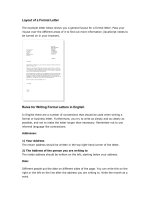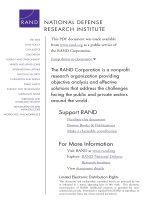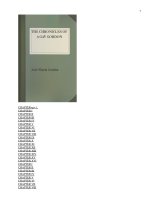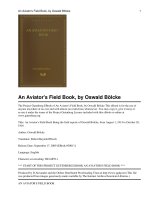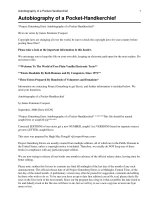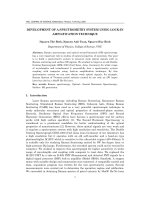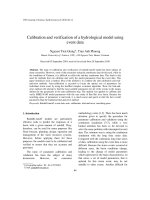improving near field confinement of a bowtie aperture using surface plasmon polaritons
Bạn đang xem bản rút gọn của tài liệu. Xem và tải ngay bản đầy đủ của tài liệu tại đây (634.45 KB, 3 trang )
Improving near-field confinement of a bowtie aperture using surface
plasmon polaritons
Pornsak Srisungsitthisunti,
1
Okan K. Ersoy,
2
and Xianfan Xu
1,a͒
1
School of Mechanical Engineering and Birck Nanotechnology Center, Purdue University, West Lafayette,
Indiana 47907, USA
2
School of Electrical and Computer Engineering, Purdue University, West Lafayette, Indiana 47907, USA
͑Received 25 March 2011; accepted 6 May 2011; published online 1 June 2011͒
Bowtie aperture is known to produce subdiffraction-limited optical spot with high intensity. In this
work, we investigate integrating a bowtie aperture with circular grooves to reduce the divergence of
the near-field produced by the bowtie aperture. Numerical results indicate that surface waves
reflected from circular grooves improve the field confinement of a bowtie aperture along the
polarization axis. These circular grooves with period near half the wavelength of surface plasmon
polaritons reduce the spot size by as much as 40% at distances between 20 and 100 nm from the
surface and create a more symmetrical optical spot. © 2011 American Institute of Physics.
͓doi:10.1063/1.3595412͔
Bowtie apertures have been shown to achieve extraordi-
nary transmission and produce subdiffraction-limited optical
spot for near-field applications such as data storage,
near-field scanning optical microscopy ͑NSOM͒, and
nanolithography.
1–3
A bowtie aperture, illustrated in Fig.
1͑a͒, can be designed to produce a subdiffraction-limited op-
tical spot shown in Fig. 1͑b͒, which is determined by the gap
between the two tips of the bowtie aperture. The field inten-
sity at the bowtie gap is orders of magnitude higher than the
incident field. Moreover, an array of bowtie apertures can
generate multiple light spots for sensing
4
and for parallel
processes.
5
However, the field beyond the surface of a
bowtie aperture is subjected to strong divergence. Conse-
quently, the working distance of the bowtie is limited to the
very near-field. The bowtie apertures are often used in con-
tact with another surface to obtain a subdiffraction spot.
5–7
In this work, we investigate a method to reduce near-
field divergence of a bowtie aperture by surrounding the
bowtie aperture with concentric grooves on the exit side of
the metal film as illustrated in Fig. 1͑c͒. Surface plasmon
polaritons ͑SPPs͒ are excited by the incident light at the
bowtie aperture. The grooves partially reflect and scatter
SPPs toward the bowtie, modifying the field divergence.
When designed properly, these grooves effectively reduce
the spot size of the propagating field. It should be noted that
the transmission of a bowtie aperture can be enhanced by
placing corrugations on the incident side,
8
which act as grat-
ings that collect more light. These gratings are effective in
improving the transmission but are not intended for narrow-
ing field concentration.
Grooves on the exit side of a metal film have been sug-
gested to obtain far-field collimation and focusing of a sub-
wavelength hole or slit.
9–14
Most of these designs are based
on SPP scattering and interference in the far-field. Each
groove scatters the SPP waves into the propagating wave
with a phase delay specified by the traveling distance from
the hole or the slit. By adjusting relative positions of the
grooves, a focused spot can be obtained by phase matching
of the scattered SPPs.
9–14
However, this far-field focusing
fundamentally limits the spot size to the diffraction limit.
SPPs can also be excited inside narrow slits. A plasmonic
lens can be designed to interfere SPPs emerging from con-
centric slits to produce a spot in the near-field.
15
Here we
investigate how the SPPs can further reduce the near-field
divergence from a bowtie aperture within a 100 nm distance
from the exit surface. A small near-field spot beyond the exit
plane is desirable for many applications requiring noncontact
between the near-field optical element and the surface the
light interacts with. For example, it will provide more posi-
tioning tolerance and design space in nanolithography,
5–7,15
data storage,
1,16
and NSOM.
2
We first investigate the behavior of a two-dimensional
͑2D͒ slit-grooves structure, which provides an understanding
a͒
Author to whom correspondence should be addressed. Electronic mail:
Quartz
Al
E
(c) (d)
y
x
|E|
2
100 nm
x
y
z
x
y
(a) (b)
E
z = 10 nm
E
FIG. 1. ͑Color online͒͑a͒ Schematic of a bowtie aperture and ͑b͒ its corre-
sponding ͉E͉
2
calculated at 10 nm distance from the surface. Modified
bowtie aperture with ͑c͒ full circular grooves and ͑d͒ partial circular grooves
on the exit side of the film.
APPLIED PHYSICS LETTERS 98, 223106 ͑2011͒
0003-6951/2011/98͑22͒/223106/3/$30.00 © 2011 American Institute of Physics98, 223106-1
Author complimentary copy. Redistribution subject to AIP license or copyright, see />of the interaction between SPPs and a diverging near-field,
and facilitates the design of the computationally more inten-
sive three-dimensional bowtie-grooves structure. All the
simulations were carried out using a finite element solver,
HFSS™.
17
The grid size is adaptive with a smallest grid size
of 2 nm in critical areas. Material properties are obtained
from Ref. 18. A 30-nm-width slit in a 100-nm-thick alumi-
num film on a quartz substrate is illuminated by a TM-
polarized 400-nm-wavelength plane wave. Since the surface
grooves are designed to concentrate light in the near-field,
the positions of the grooves are distributed evenly. For para-
metric studies, the periodicity of the grooves is varied from
50 to 600 nm with an increment of 25 nm. The depth of the
grooves is fixed as half of the film thickness ͑50 nm͒ and the
grooves’ width is half the periodicity. For simplicity, the slit-
to-groove distance is set equal to the periodicity.
Figures 2͑a͒ and 2͑b͒ compare the electric field distribu-
tion of the slit ͑only͒ and the slit with grooves. Clearly, the
grooves create a directional field beaming in the propagating
direction compared to a single slit. Figure 2͑c͒ plots the full-
width at half-maximum ͑FWHM͒ of the slit with grooves
normalized to that of the single slit as a function of groove
periodicity. The periodicities near 200 and 400 nm show sig-
nificant FWHM reduction as much as 40%. The reduced
FWHM repeats every 200 nm of periodicity, close to half the
SPP wavelength ͑
SPP
͒, which is 391 nm for Al/air interface.
At these periodicities, the grooves produce standing waves
matching the SPP wavelength. Superposition of these stand-
ing waves and the emerging field at the slit leads to a nar-
rower field. When changing the film and media materials, we
found that the optimum periodicities depend on the SPP
wavelength which is a function of free space wavelength,
metal film, and media properties.
Our optimized periodicity of about
SPP
/ 2 differs from
the results of far-field collimation by grooves for which the
optimized grooves spacing is close to
SPP
.
9–13
This is be-
cause the mechanism of reducing the near-field confinement
is different from diffraction in far-field collimation. For far-
field collimation, the relative phase difference of waves pro-
duced by each groove is 2
to achieve constructive interfer-
ence. This is equivalent to a groove spacing of
SPP
.Onthe
other hand, for focusing light in the near-field, since the SPPs
are initially excited at the slit and travel to the grooves, the
groove spacing of
SPP
/ 2 provides 2
phase modulation
when the wave propagates to and reflects from the groove.
A close examination of Fig. 2͑b͒ indicates that SPP
waves are excited at the edges of each groove and stronger
fields are located at the closer edges to the central slit. There-
fore, the distances between these edges and the central slit
have the largest effect on the superimposed field. On the
other hand, the width of the groove controls the relative
phase of the SPPs generated at the two edges of each groove.
The depth of the grooves also influences the relative phase of
the SPPs. For a deeper groove, SPPs propagate and reflect
inside the groove through a longer distance, leading to an
increased phase delay.
14
In our case, the film thickness is
much smaller than the wavelength, so the groove depth is
less influential.
Next, we consider a bowtie aperture surrounded by con-
centric grooves as shown in Fig. 1͑c͒. In our earlier studies,
19
the geometry of a bowtie aperture has been optimized to
achieve resonant condition and maximum transmission at
400 nm wavelength. The following parameters are used for
the bowtie aperture, the length is 100 nm on all sides with a
45° angle, and the gap is 30 nm which is a dimension readily
fabricated using focused ion beam milling. The bowtie aper-
ture is made in 100-nm-thick aluminum film deposited on a
quartz substrate. The grooves have a periodicity of 200 nm,
depth of 50 nm, width of 100 nm, and the bowtie to groove
͑center-to-center͒ distance of 200 nm. The bowtie aperture is
excited with a 400-nm-wavelength plane-wave polarized
along the y-direction.
The calculation results indicate a smaller optical spot
along the y-direction when the grooves are present. Figure 3
compares the field distributions with and without grooves. A
single bowtie produces an elliptical spot beyond the exit
plane due to a strong dipolelike field with a larger size in the
y-direction. This asymmetry becomes more severe at longer
distances as shown in Figs. 3͑a͒–3͑c͒. When the grooves are
present, the SPPs are partially reflected back toward the
bowtie. With periodicity close to half the SPP wavelength,
the reflected SPPs superimpose with the propagating field.
The resulting FWHM is smaller along the y-axis, and the
spot becomes considerably more symmetric. The FWHMs in
the y-direction are reduced by 15%–35% at distances 20–100
nm from the surface.
Since the grooves only produce strong effect along the
y-axis, we also investigated partial grooves as shown in Fig.
1͑d͒. Figure 4 compares the bowtie-grooves structure with
different groove coverage angles as defined in Fig. 1͑d͒.It
shows that partial grooves with a 45° angle are as effective
as full grooves for reducing the spot size. The grooves with
an angle smaller than 45° reflect less SPPs, resulting in less
confinement in the field. Figure 4 also shows that at distances
60–80 nm, the grooves are most effective and reduce the
FWHM by 35%. At a distance smaller than 20 nm, the field
produced by the bowtie is extremely strong so that the
FWHM is less affected by the SPPs, similar to the case of 2D
(a)
(b)
E
Al
E
QuartzQuartz
Al
AirAir
0
0.5
1
1.5
2
2.5
3
3.5
4
100 200 300 400 500 600
10nm
30nm
50nm
Normalized F WHM
Periodicit
y(
nm
)
Distance (z)
(c)
FIG. 2. ͑Color online͒ Normalized electric field distribution from ͑a͒ a
single slit and ͑b͒ slit with exit grooves with 200 nm periodicity. The arrow
indicates the light irradiation direction. ͑c͒ FWHM of the emerging field of
structure in ͑b͒ normalized by ͑a͒ as a function of groove periodicity. The
slits are illuminated by a 400-nm-wavelength linearly polarized light.
223106-2 Srisungsitthisunti, Ersoy, and Xu Appl. Phys. Lett. 98, 223106 ͑2011͒
Author complimentary copy. Redistribution subject to AIP license or copyright, see />slit-grooves. The inset of Fig. 4 shows that the dimension in
the x-direction is essentially not affected due to the lack of
SPPs.
In summary, we proposed a method for reducing the
near-field divergence of the subdiffraction-limited spot cre-
ated by a bowtie aperture, using SPPs reflected from grooves
surrounding the bowtie aperture. The near-field confinement
is based on superposition of the central field and the reflected
SPPs. The results confirm a spot reduction as much as 40%
for the 2D slit-grooves and 35% for the bowtie-grooves
structure. This approach is especially suitable for the bowtie
aperture where the divergence is strong along the polariza-
tion axis, producing a more symmetric optical spot. These
simple additions make bowtie aperture a more attractive de-
vice for near-field applications where direct contact between
the bowtie aperture and another surface is not desirable.
The authors gratefully acknowledge the support of the
National Science Foundation ͑Grant No. DMI-0707817͒, the
Defense Advanced Research Projects Agency ͑Grant No.
N66001-08-1-2037͒, and the AFOSR-Multidisciplinary Uni-
versity Research Initiative program ͑Grant No. FA9550-08-
1-0379͒.
1
K. Şendur, W. Challener, and C. Peng, J. Appl. Phys. 96,2743͑2004͒.
2
L. Wang and X. Xu, Appl. Phys. Lett. 90, 261105 ͑2007͒.
3
L. Wang, S. M. Uppuluri, E. X. Jin, and X. Xu, Nano Lett. 6,361͑2006͒.
4
E. Kinzel and X. Xu, Opt. Lett. 35, 992 ͑2010͒.
5
S. M. V. Uppuluri, E. C. Kinzel, Y. Li, and X. Xu, Opt. Express 18, 7369
͑2010͒.
6
N. Murphy-DuBay, L. Wang, and X. Xu, Appl. Phys. A: Mater. Sci. Pro-
cess. 93, 881 ͑2008͒.
7
Y. Kim, S. Kim, H. Jung, E. Lee, and J. W. Hahn, Opt. Express 17, 19476
͑2009͒.
8
E. C. Kinzel, P. Srisungsitthisunti, Y. Li, A. Raman, and X. Xu, Appl.
Phys. Lett. 96, 211116 ͑2010͒.
9
S. Kim, Y. Lim, H. Kim, J. Park, and B. Lee, Appl. Phys. Lett. 92, 013103
͑2008͒.
10
H. J. Lezec, A. Degiron, E. Devaux, R. A. Linke, L. Martin-Moreno, F. J.
Garcia-Vidal, and T. W. Ebbesen, Science 297, 820 ͑2002͒.
11
F. J. García-Vidal, L. Martín-Moreno, H. J. Lezec, and T. W. Ebbesen,
Appl. Phys. Lett. 83, 4500 ͑2003͒.
12
L. Martín-Moreno, F. J. García-Vidal, H. J. Lezec, A. Degiron, and T. W.
Ebbesen, Phys. Rev. Lett. 90, 167401 ͑2003͒.
13
F. Hao, R. Wang, and J. Wang, Opt. Express 18, 15741 ͑2010͒.
14
H. Shi, C. Du, and X. Luo, Appl. Phys. Lett. 91, 093111 ͑2007͒.
15
W. Srituravanich, L. Pan, Y. Wang, C. Sun, D. B. Bogy, and X. Zhang,
Nat. Nanotechnol. 3, 733 ͑2008͒.
16
W. A. Challener, C. Peng, A. V. Itagi, D. Karns, W. Peng, Y. Peng, X.
Yang, X. Zhu, N. J. Gokemeijer, Y. T. Hsia, G. Ju, R. E. Rottmayer, M. A.
Seigler, and E. C. Gage, Nat. Photonics 3, 220 ͑2009͒.
17
Ansoft Inc., HFSS 12.1.1 software, 2009.
18
P. B. Johnson and R. W. Christy, Phys. Rev. B 6,4370͑1972͒.
19
L. Wang and X. Xu, Appl. Phys. A: Mater. Sci. Process. 89,293͑2007͒.
|E|
max
= 0.25
|E|
max
= 0.30
z=100nm
149×222 nm
154×169 nm
z = 100 nm
z=20nm |E|
max
1.50
|E|
max
1.30
|E|
max
=0.50|E|
max
= 0.65
z=50nm
54×72 nm
88×121 nm
52×65 nm
87×88 nm
y
x
z = 20 nm
z = 50 nm
(a)
(b)
(c)
(d)
(e)
(f)
E
FIG. 3. ͑Color online͒ Comparison of electric field distributions of ͓͑a͒–͑c͔͒
single bowtie aperture and ͓͑d͒–͑f͔͒ bowtie aperture with circular grooves at
working distances of 20, 50, and 100 nm. The bowtie apertures are excited
by a plane-wave whose electric field is linearly polarized along the y-axis.
0
50
100
150
200
250
0 20406080100
Bowtie only
Bowtie-gratings-full
Bowtie-gratings-45
Bowtie-gratings-30
Bowtie-gratings-15
Working Distance (nm)
FWHM-X (nm)
FWHM-Y (nm)
Workin
g
Distance
(
nm
)
20
40
60
80
100
120
140
160
020406080100
FIG. 4. ͑Color online͒ FWHM of ͉E͉
2
along y-direction and x-direction
͑inset͒ of a bowtie and a bowtie surrounded by grooves with different an-
gular coverage.
223106-3 Srisungsitthisunti, Ersoy, and Xu Appl. Phys. Lett. 98, 223106 ͑2011͒
Author complimentary copy. Redistribution subject to AIP license or copyright, see />
